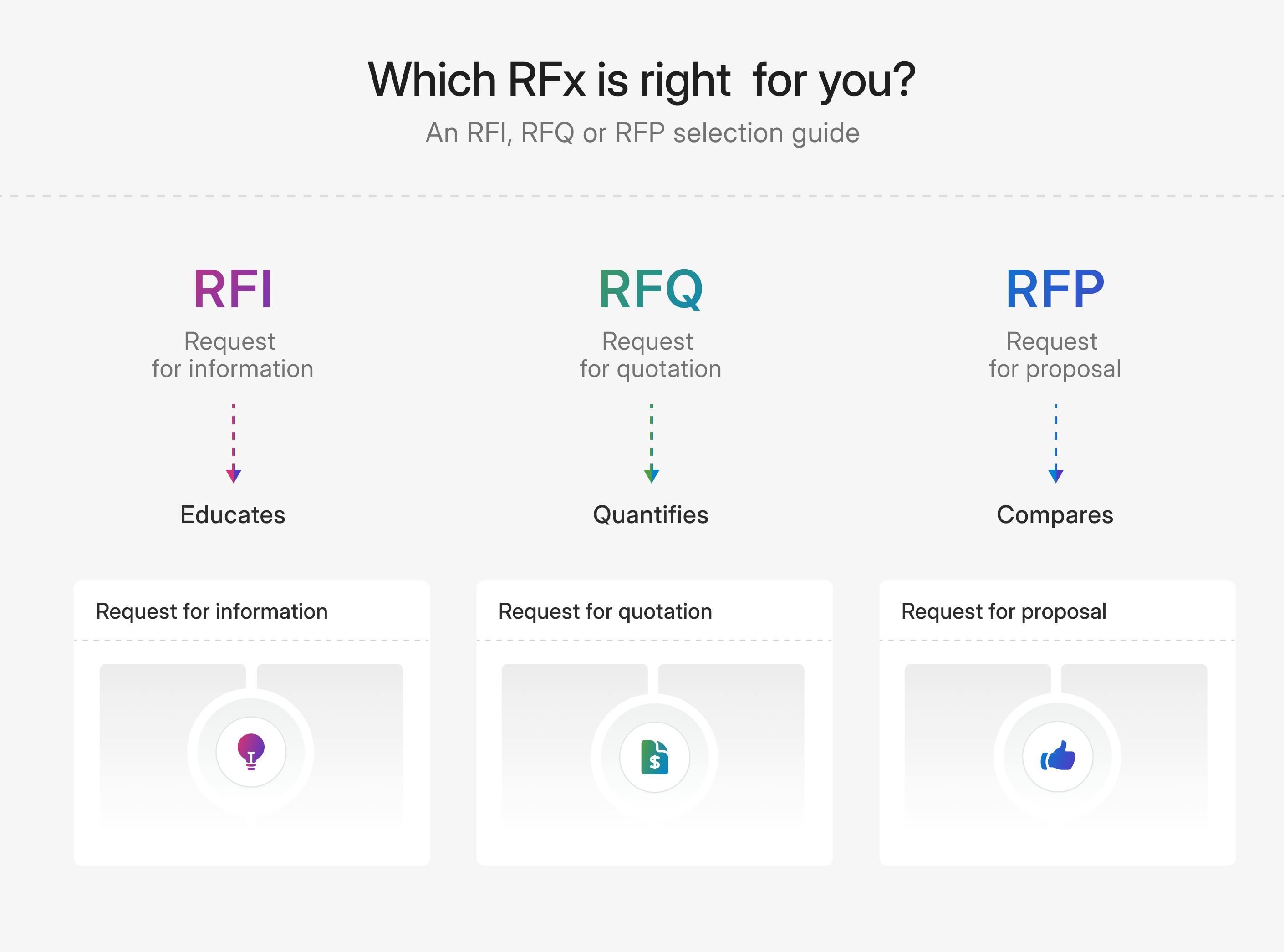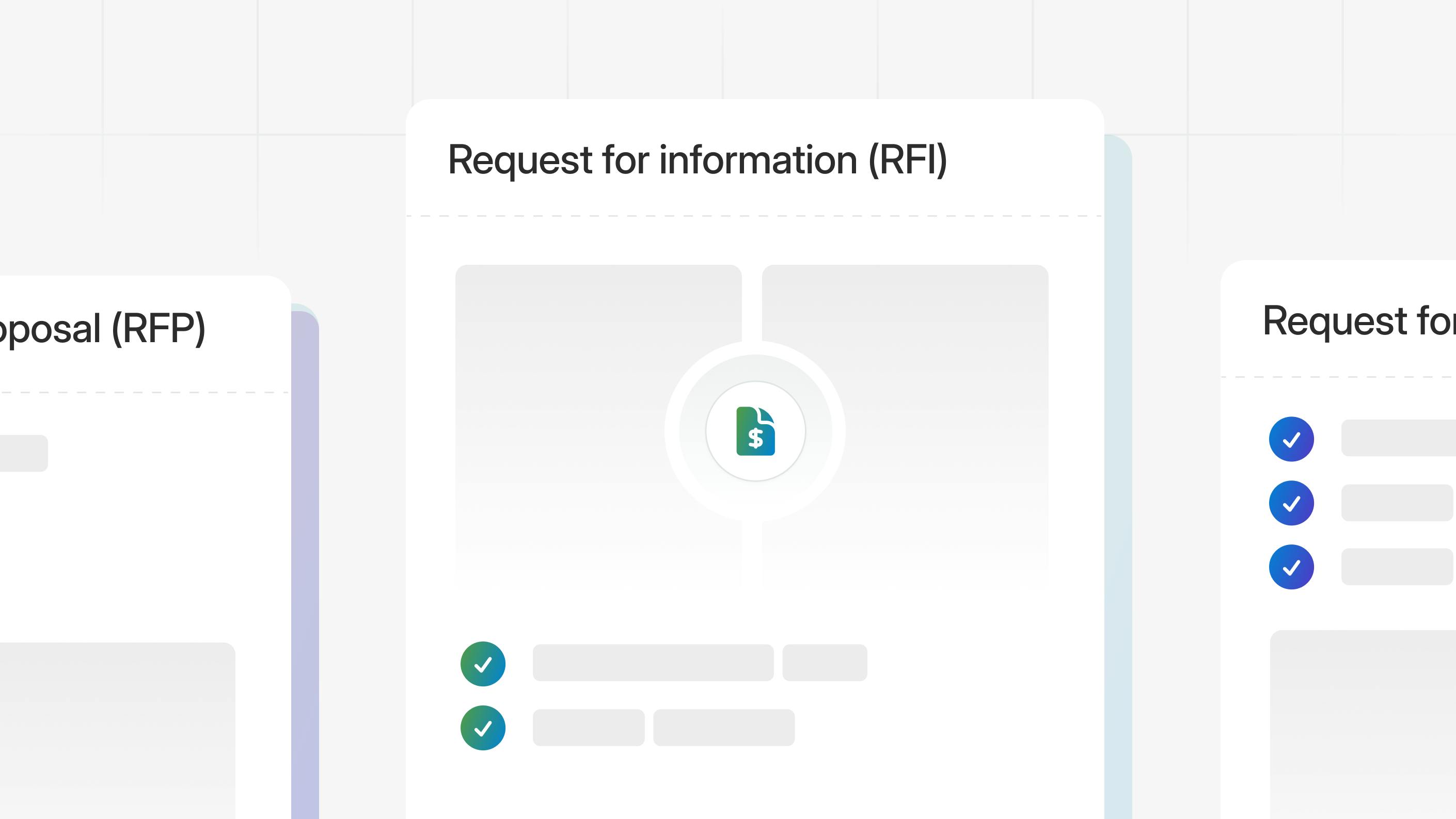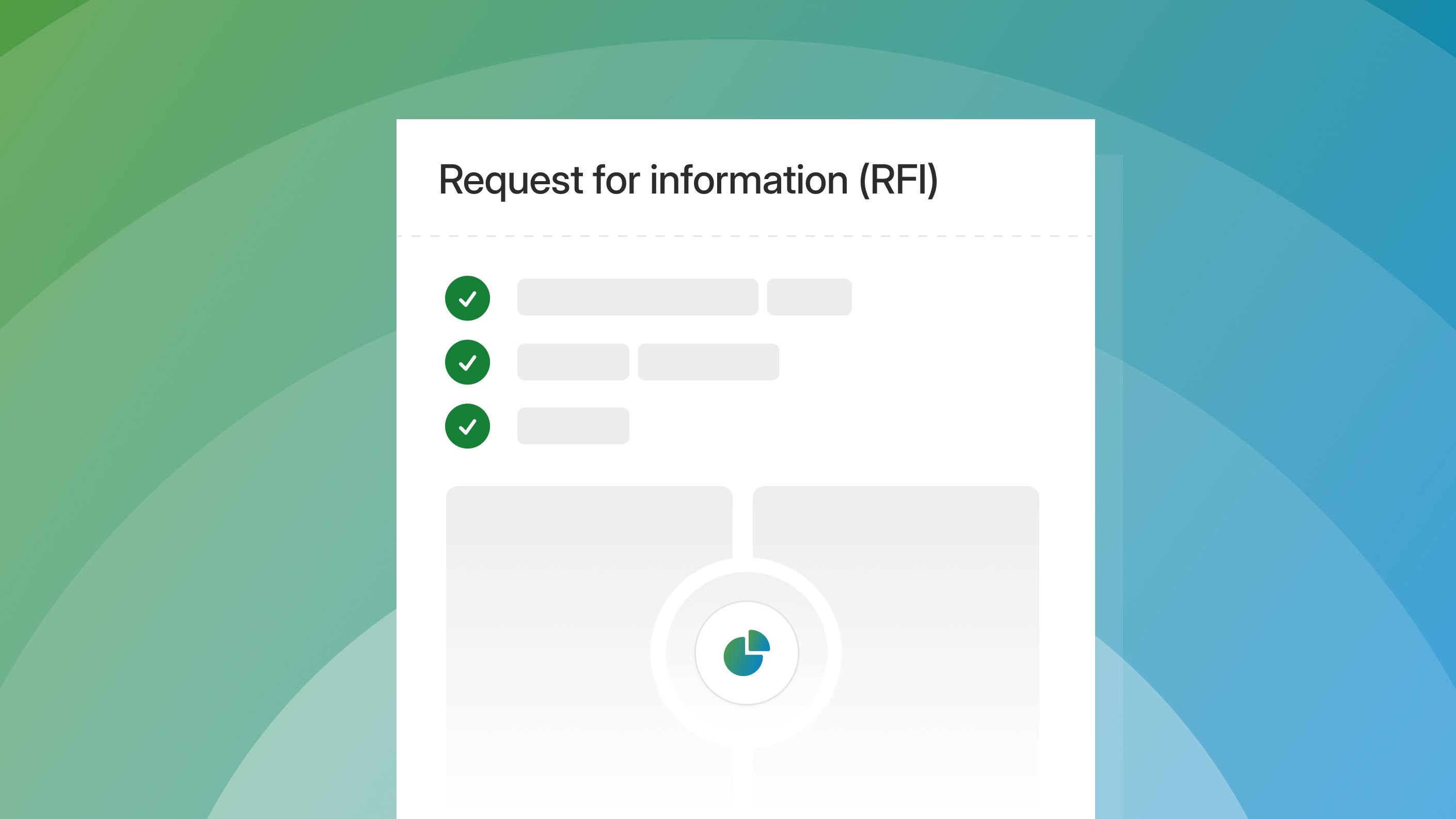When your business encounters a challenge, how do you quickly find and compare potential vendors? Searching online manually can be inefficient, inconsistent, and incomplete. A Request for Information (RFI) provides a standardized way to engage vendors collaboratively, helping you clearly understand available solutions.
In this blog, we’ll explain what an RFI is, its purpose, and who typically issues one. You'll also learn how to write an effective RFI using our tips and best practices, plus get access to an RFI template and real-life examples.
Why RFIs matter:
Over 75% of organizations reported in a recent study that buyers now expect faster responses, higher personalization, and more comprehensive details, increasing the pressure on response teams. RFIs aren't just information gathering tools—they are pivotal in shaping early buyer perceptions, qualifying opportunities, and positioning your solutions strategically.
Key components of an effective RFI template:
- Clear introduction: Briefly introduce your organization, emphasizing your value proposition tailored to the RFI issuer's industry.
- Structured answers: Clearly organize your responses, directly addressing the issuer's questions with concise, relevant information.
- Supporting documentation: Include references to additional resources or case studies that substantiate your answers.
- Closing statement: Reinforce your interest, suggest next steps, and offer further engagement options.
Who uses RFIs?
RFIs are used by around 83 percent of procurement professionals regularly. In fact, 25 percent of respondents estimate that they issue more than 50 RFIs per year.
Procurement consultants also use RFIs, including those who specialize in technology, financial services, employee benefits, and more.
When should you issue an RFI?

Using an RFI for research and planning
An RFI is often the first step in procurement when you’re facing a challenge but unsure about potential solutions or if a purchase is needed. RFIs help you explore the market, understand available options, and familiarize yourself with vendors. RFIs enable you to gather expert insights from vendors, making you a more informed buyer.
Possible outcomes of an RFI:
- Create a shortlist of vendors for a more detailed RFP.
- Issue a contract directly if there's a clear, low-risk vendor choice.
- Delay, modify, or abandon the project if it’s impractical or out of budget.
Using an RFI for recurring procurements
RFIs can also help build vendor profiles for ongoing procurement needs. For instance, employee benefits consultants often maintain these profiles to quickly identify suitable vendors for future RFPs. This approach streamlines the process, making subsequent RFPs shorter and more targeted.
Understanding the RFI process
The RFI process comes down to three steps: creation, administration and evaluation.
1. Creation
- Define your need and create a problem statement
- Provide background about your company
- Write RFI questions to gather information
2. Administration
- Select vendors to include and send the RFI
- Answer any follow up questions
- Gather vendor responses
3. Evaluation
- Review vendor responses for viability
- Compare vendor offerings
- Consult stakeholders on findings
- Determine next steps
What should RFI templates include?

An RFI template can be shaped to cover nearly any situation. Whether you need information on technology and consultants, or you have a specific project you need help with, an effective RFI template typically consists of the following five sections:
- Project description, goals and background — Goals and objectives
- Company information — Context about your organization
- Vendor requirements — Skills and credentials you’re looking for
- Submission instructions — How you’d like responses formatted
- Requested information — Questions exploring the vendor’s company, their solution, experience and pricing
Writing an effective RFI can be difficult and time-consuming. Instead of starting from scratch, it can be helpful to start with a proven and customizable RFI template. To help, we’ve prepared a short list of RFI templates below you can use and customize to get started.
Industry-specific RFI templates:
Ad agency RFI template
Demand Metric designed this RFI template to help organizations evaluate advertising agencies. What makes it so valuable is that it asks responders to provide a list of current industry-specific clients, relevant success stories and potential conflicts of interest.
When working with an ad agency, it’s important to know whether they’ve had proven success with organizations like yours. In addition, if they’re creating advertisements for your competition while soliciting your business, you’ll want to know that, too.
EHR RFI template
This electronic health record (EHR) template covers a wide range of topics including: product questions, customer reference questions, functional and technical requirements, operational requirements, transitional requirements, and more.
ERP RFI template
This enterprise resource planning (ERP) RFI template details the criteria procurement teams should look for in an ERP, including requirements related to: accounting, human resources, manufacturing management, inventory management, purchasing management, sales management, and technology.
While this template is thorough, it’s unlikely you can copy and paste the content into a document containing your logo and call it a day. You’ll need to tailor the language and requirements to meet your needs.
IT sourcing RFI template
This IT sourcing RFI template was designed for banks looking to outsource IT work. It allows banks to simply search and replace “The Bank” with their name. However, we still suggest tailoring the language and requirements to your situation.
Construction industry RFIs
RFIs are common in the construction industry, too. However, these RFIs serve two different purposes. When used as a part of the procurement process, a construction RFI functions identically to any other RFI. Just like a construction RFP, a business issues the RFI and a firm responds. On the other hand, an RFI form used during the course of construction seeks additional clarification and guidance about the project.
Questions will inevitably arise. No amount of planning, specifications, or blue prints can account for every real-world eventuality. When issues arise and the general contractor cannot proceed, they issue an RFI form to the client to seek clarification on the specific issue.
Financial services
Companies frequently use RFIs to review vendors based on secure data management, effective scalability, transaction tracking, and the wealth and depth of integrations available.
Real RFI examples
NASA Space Shuttle Orbiter display RFI
This NASA RFI example seeks to “make decisions regarding development of strategies for placement of Space Shuttle Orbiters and Space Shuttle Main Engines (SSMEs) for public display.” Understandably, NASA has stringent requirements, and this document can be used to get a feel for how to write a professional RFI with strict criteria.
Michigan Virtual University LMS RFI
Michigan Virtual University (MVU) issued this RFI to identify a replacement learning management system (LMS). To ensure vendors provide responses they can easily evaluate, MVU set clear expectations and standardized responses by asking vendors to demonstrate their proficiency in 10 scenarios.
Real results in managing RFIs with Responsive

Microsoft supports 21,000 content library users with AI
Microsoft leveraged a streamlined RFI process integrated with their MSFT tech stack to improve response quality and efficiency. The result? A savings of $6.2 million and over 31,000 production hours in a single year, dramatically enhancing their competitive positioning.
Additionally, Microsoft’s worldwide sales organization used AI-powered answers (drawn from over 20,000 resources) more than 200,000 times in sales proposals, RFPs, RFIs, and security, legal, and compliance assessments.
Availity advances 88% of deals using Responsive AI
Availity operates in the highly regulated healthcare environment, where data security and compliance are essential. This growing demand for RFPs, RFIs, and detailed security questionnaires stretched internal resources, which often became a bottleneck due to the need for technical responses.
Additionally, an outdated knowledge base hindered quick, accurate, and consistent proposal responses, while their existing RFP software lacked the scalability to handle a faster, more complex sales process.
After partnering with Responsive:
- 88% of of deals advance beyond RFPs and RFIs
- 50% of all Availity’s RFPs, RFIs, and VSQs are now completed by Responsive AI
O.C. Tanner boosted productivity by 43% and saved $150K a year
O.C. Tanner was using RFP software that could not keep up with their growing volume of RFPs, RFIs, VSQs, and client follow-up queries. Responsive helped O.C. Tanner consolidate response content into a library that the Strategic Solutions Team uses as a single source of truth.
Through enhanced efficiency and cross-functional collaboration, the Strategic Solutions Team kept up with growing demand and increased productivity by 43% in 2024.
After partnering with Responsive:
- $150,000 saved in hours spent searching for content for responses to RFPs, RFIs, and follow-up sales presentations.
- 400% growth in average deal size
Optimizing your RFI process with Responsive:
Responsive streamlines the procurement process by making it easy to create and send RFIs, RFPs, RFQs, and more, while also providing a simple and effective way to evaluate vendor responses.
The Responsive Platform allows you to:
- Centralize all response content in an accessible, AI-powered Content Library.
- Automate workflows, making collaboration seamless across teams and locations.
- Quickly generate accurate first drafts using Responsive AI, significantly reducing response time.
In fact, organizations that integrate SRM into their RFI processes report a 15% increase in win rates and submit 67% more proposals annually without adding headcount.
